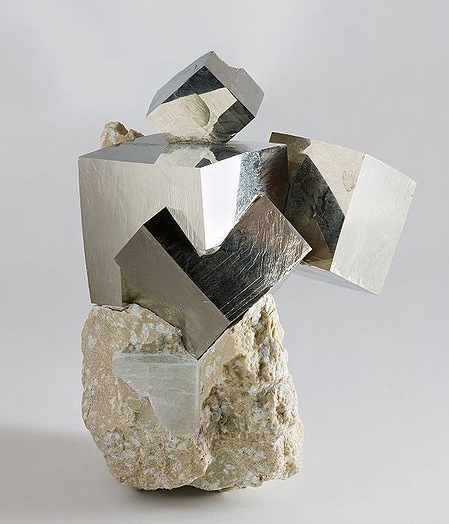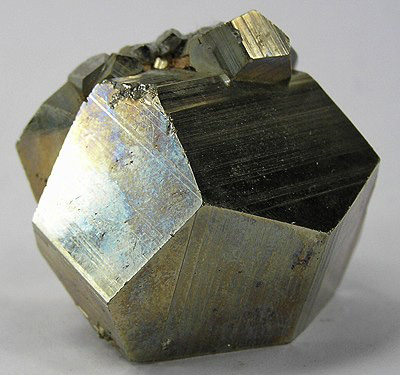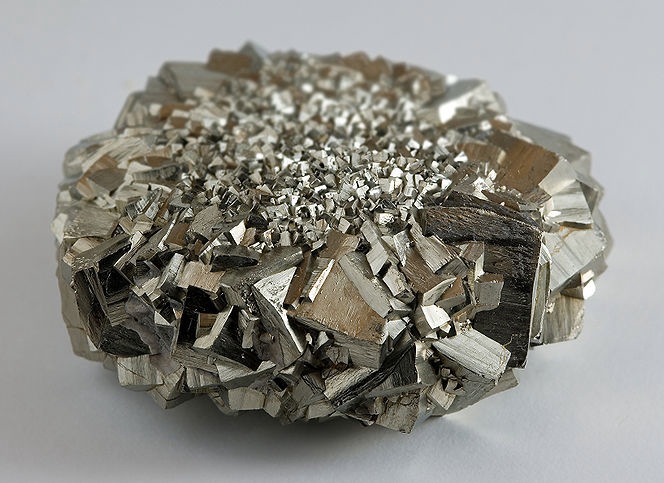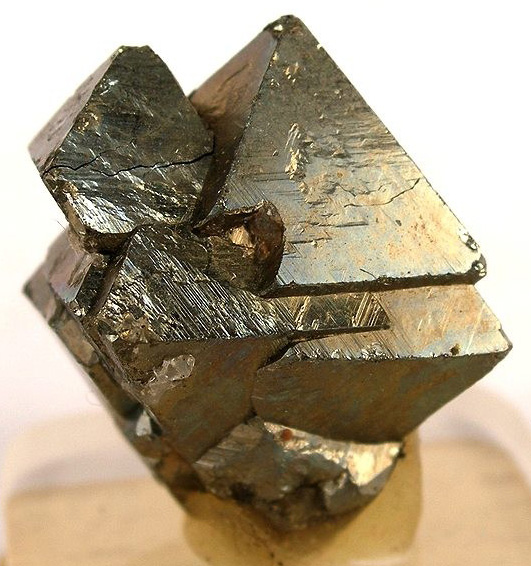Pyrite
Pyrite, more properly called iron pyrite, is a famous mineral with the chemical formula FeS2 (iron sulphide). [1] Its nickname is "fools gold" owing to its golden color, and it a very common mineral found in a wide variety of environments all over the world. Pyrite is not all that difficult to distinguish from pure gold: It has a hardness of 6-6.5 (Mohs) - much harder than gold (and lighter), and it cannot be so easily scratched as gold. [2]

Pyrite cubes
From La Rioja, Spain. Yes, they really do grow this way naturally!
Pyrite can occur in many forms - crystalline (cubic, octahedral, pyritohedral), granular, massive, globular or stalatcitic. [1] It is also commonly seen in association with other crystals, such as fluorite, apatite, quartz or afghanite. A pyritohedron is an irregular dodecahedron - a 12-sided object with pentagonal faces of irregular shape. In nature, no crystalline substance of any kind has been found with an absolutely regular dodecahedral shape [3] - although sometimes dodecahedral pyrite crystals can come quite close, as can be seen in the second of the images. Pyrite's faces can sometimes be quite smooth, although they are often striated (marked with parallel lines).
One of pyrite's fascinating qualities, as can be seen clearly in the top image, is its ability to intergrow. The cubes in the topmost image appear to have melded with each other without losing their individual form - and sometimes fantastic "chains" of intergrown cubes can be found. This quality is renowned with the pyrite cubes that come from Spain.
Although a source of delight to crystal enthusiasts, pyrite can be a source of consternation in some industrial scenarios. Iron pyrite in high-sulphur coal mines has been known to oxidise generating enough heat to cause dangerous explosions - and solutions to this have been either to seal off mined-out areas, or to spray limestone dust onto the exposed surface. Pyrite has also been known to pose problems if present in the materials used to make concrete; as its oxidization can cause deterioration of the concrete. [1]
Pyrite was used in early firearms of the 16th and 17th centuries as the "flint" to make the spark - and its name comes form the Greek "pyrites lithos" which means "stone which strikes fire". [4] Pyrite also has had many industrial uses from radio to solar cell technology - as well as being used in jewelry. When used decoratively, pyrite is most often kept in its original state, due to the interesting and attractive shapes it forms.
More Pyrite Images

"Pyritohedron" from Hunan, China.
Photo by Rob Lavinsky, iRocks.com - image lic. under CC-BY-SA-3.0

Pyrite
Photo by J J Harrison - lic. under Creative Commons 3.0

Pyrite Octahedron from from Hunan, China.
Photo by Rob Lavinsky, iRocks.com - image lic. under CC-BY-SA-3.0
Pyrite - Sources Referenced:
[1] http://en.wikipedia.org/wiki/Pyrite
[2] http://www.mindat.org/min-3314.html
[3] http://en.wikipedia.org/wiki/Pyritohedron
[4] http://webmineral.com/data/Pyrite.shtml
Back to the Gemstones List home page - over 160 gemstones explored!
Please feel free to link to this page - copy / paste the text below: (click to select)
Privacy Policy | Cookie Policy | GDPR | About This Site / Terms

© gemstoneslist.com


